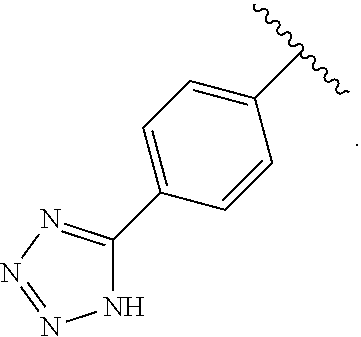Therapeutic catechols
a catechol and therapy technology, applied in the field of catechols, can solve the problems of limited treatment options for influenza, ineffectiveness of adamantane drugs, amantadine and rimantadine, and drugs, in general, that are not in clinical use, and achieve the effect of promoting an antiviral
- Summary
- Abstract
- Description
- Claims
- Application Information
AI Technical Summary
Benefits of technology
Problems solved by technology
Method used
Image
Examples
example 1 preparation
of Compound
[0084]
[0085]To a cooled solution of 4,4″-difluoro-4′,5′-dimethoxy-1,1′:2′,1″-terphenyl (125 mg, 0.38 mmol) in anhydrous DCM (5 mL) was slowly added BBr3 (1.0 M in DCM) (2 mL, 1.92 mmol). Reaction was removed from ice bath and stirred overnight at RT. Solvents were then evaporated. Chromatography using ISCO max gradient 2% MeOH / DCM yielded product as a tan solid (113 mg, quantitative); 1H NMR (400 MHz) (CDCl3) δ 6.95-6.91 (m 4H), 6.83-6.79 (m, 6H), 5.21 (bs, 2H); 13C NMR (100 MHz) (CDCl3) δ 161.6 (JC,F=245 Hz), 142.8, 136.8, 132.8, 131.3 (JC,F=8 Hz), 117.5, 114.8 (JC,F=21 Hz).
[0086]The intermediate 4,4″-difluoro-4′,5′-dimethoxy-1,1′:2′,1″-terphenyl was prepared as follows.
a) Preparation of Compound
[0087]
[0088]To a cooled solution of 4,5-dibromoveratrole (1 g, 3.38 mmol) in anhydrous DCM (5 mL) was slowly added BBr3 (1.0 M in DCM) (17 mL, 16.9 mmol). Reaction was removed from ice bath and stirred overnight at RT. Solvents were then evaporated. Chromatography using ISCO max ...
example 2 preparation
of Compound
[0091]
[0092]To a cooled solution of 4,4″-difluoro-4′,5′-dimethoxy-3′-nitro-1,1′:2′,1″-terphenyl (65 mg, 0.175 mmol) in anhydrous DCM (3 mL) was slowly added BBr3 (1.0 M in DCM) (3 mL, 0.88 mmol). Reaction was removed from ice bath and stirred overnight at RT. Solvents were then evaporated. Chromatography using ISCO max gradient 2% MeOH / DCM yielded product as a yellow solid (42 mg, 70% yield); 1H NMR (400 MHz) (CD3OD) δ 7.07-7.02 (m, 4H) 6.95-6.88 (m, 5H); 13C NMR (100 MHz) (CD3OD) δ 164.8-161.9 (m), 147.3, 143.2, 138.6, 137.5 (JC,F=4 Hz), 133.3 (JC,F=9 Hz), 132.8-132.7 (m), 124.2, 118.6, 115.9-115.5 (m).
[0093]The intermediate 4,4″-difluoro-4′,5′-dimethoxy-3′-nitro-1,1′:2′,1″-terphenyl was prepared as follows.
a) Preparation of Compound
[0094]
[0095]To a cooled solution of 1,2-dibromo-4,5-dimethoxy-3-nitrobenzene (35 mg, 0.1 mmol) in anhydrous DCM (2.5 mL) was slowly added BBr3 (1.0 M in DCM) (0.5 mL, 0.5 mmol). Reaction was removed from ice bath and stirred overnight at RT. ...
example 3 preparation
of Compound
[0100]
[0101]To a cooled solution of 4′,5′-dimethoxy-[1,1′:2′,1″-terphenyl]-4,4″-dicarbonitrile (493 mg, 1.45 mmol) in anhydrous DCM (7 mL) was slowly added BBr3 (1.0 M in DCM) (7.3 mL, 7.25 mmol). Reaction was removed from ice bath and stirred overnight at RT. Solvents were then evaporated. Chromatography using ISCO max gradient 2% MeOH / DCM yielded product as a white solid (104 mg, 23% yield); 1H NMR (400 MHz) (DMSO-d6) δ 9.52 (bs, 2H), 7.69 (d, J=8.2 Hz, 4H), 7.20 (d, J=8.2 Hz, 41-H), 6.85 (s, 2H); 13C NMR (100 MHz) (DMSO-d6) δ 145.9, 145.7, 132.0, 130.5, 129.5, 118.8, 117.7, 108.9.
[0102]The intermediate 4′,5′-dimethoxy-[1,1′:2′,1″-terphenyl]-4,4″-dicarbonitrile was prepared as follows.
a) Preparation of 4′,5′-Dimethoxy-[1,1′:2′,1″-terphenyl]-4,4″-dicarbonitrile
[0103]
[0104]A flask containing 4,5-dibromoveratrole (407 mg, 1.375 mmol), 4-cyanophenylboronic acid (606 mg, 4.125 mmol), Pd(PPh3)4 (159 mg, 0.1375 mmol), and Na2CO3 (729 mg, 6.875 mmol) was degassed and dioxane (6...
PUM
| Property | Measurement | Unit |
|---|---|---|
| temperature | aaaaa | aaaaa |
| temperature | aaaaa | aaaaa |
| volume | aaaaa | aaaaa |
Abstract
Description
Claims
Application Information
 Login to View More
Login to View More - R&D
- Intellectual Property
- Life Sciences
- Materials
- Tech Scout
- Unparalleled Data Quality
- Higher Quality Content
- 60% Fewer Hallucinations
Browse by: Latest US Patents, China's latest patents, Technical Efficacy Thesaurus, Application Domain, Technology Topic, Popular Technical Reports.
© 2025 PatSnap. All rights reserved.Legal|Privacy policy|Modern Slavery Act Transparency Statement|Sitemap|About US| Contact US: help@patsnap.com



